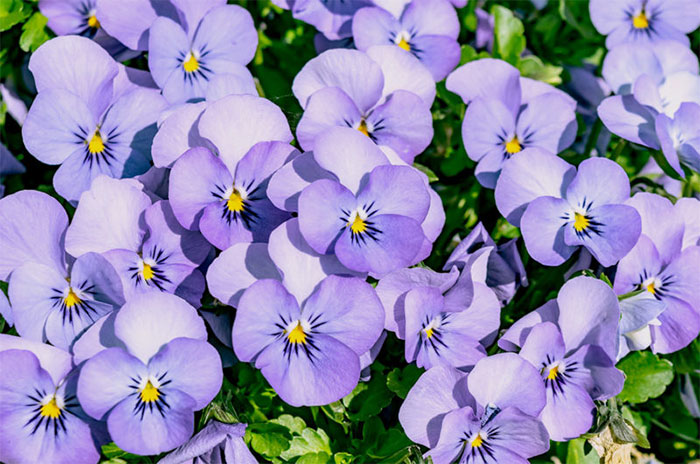Violet Flower Symbolism Facts & Meaning: Zodiac, Superstitions, Dreams, and Legends
I
Violet Flower Facts
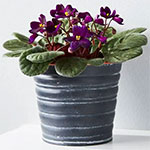
Despite native to the Northern Hemisphere, the flowers can also be found in Australia, the Andes, Hawaii, and some parts of South America. Especially in areas where deciduous trees provide cover and protection for vegetation, the flowers are typically found in hedgerows and shaded areas.
Wild Violets, violas, johnny jump-ups, and pansies are examples of Violets. They all produce wonderful ground covers, and many of them look stunning when planted in window boxes, porch pots, or hanging baskets. Violets can reach heights of one foot and widths of twenty inches.
While some Violet species have short legs with alternately-positioned leaves, others have long legs with no stalks and has rose-shaped leaves that formed from the ground up. Violet Flower leaves can be velvety or coated in tiny, thin hairs, depending on the variety of the Violet Flower.
While some species of Violets may self-pollinate, others are in need of pollination by the help of insects. Both male and female reproductive organs can be found in Violet plants. Violet Flowers can have purple, blue, white, cream, or multicolored petals, depending on the species.
The smell of Violet Flowers is due to the presence of scent-producing compounds including terpenes and ionones. Some Violet blossoms, however, have a perfume so strong that it interferes with your capacity to determine other smells.
The Violet Flower’s fruit (capsule), which contains small seeds, splits from the mother plant in an explosion-like motion. It is either an annual or perennial plant, but the lifespan of Violet Flowers usually lasts for more than two years, depending on the species and region.

II
Violet Flower Uses
Anthocyanins and cyclotides, which are found in Violet Flowers, operate as antioxidants, with antiviral and antibacterial activities, besides being known as a good protectant against insect pests.
Salicylic acid, the primary component of aspirin, is also available in Violets in very small amounts. Many Violet varieties have been employed for a number of purposes, including the treatment of cancer. Violet leaves are rich in vitamins A and C.
The legs, leaves, and flowers can be used to ease anxiety and stomach pain as well as manage chest congestion and sore throat. The small leaves and flowers are edible which can be used as raw ingredients in salads, as cooked ingredients in sauces and jellies, as well as decorations for cakes and other sweets. Even today, Violets are used to thicken soup, salads, tea, and when made properly, desserts.
Due to the plant’s powerful odor, Violet blossoms are widely utilized in perfume making and are actually quite popular.
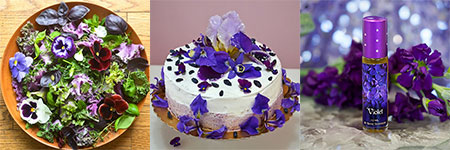
III
Violet Flower History
The earliest people to recognize Violet blossoms were the ancient Greeks, who lived around 500 B.C. Both ancient Greeks and Romans believed that this flower is useful as a natural remedy for a variety of illnesses.
During celebrations, people also made wine from the blossoms as well as to sweeten their cuisine. At that time, the cultivation of this flower began. The historical use as a medication was to treat heart disease which is where the moniker “Heartsease” came from. People used to think of it as a reason the plant’s heart-shaped leaves were there. In another thought however, the name might perhaps have originated from its historical use as a love potion and aphrodisiac.
Eventually, the Violet perfume business started to become known. They used oil from the deep purple “Viola odorata,” a native of the Mediterranean region.
In 1814, a story says that Josephine Bonaparte’s grave was decorated with Violet Flowers by Napoleon Bonaparte. He designated Violets as his official symbol flower as well. Napoleon consequently received the designation, Corporal Violet.
IV
Violet Flower Positive Symbolism
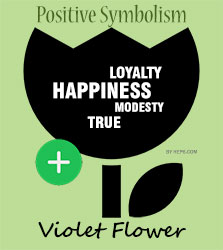
You may want to “take a chance on happiness,” that is what the white Violets are known to symbolize. To “always be true” is for blue Violets.
White Violets also represent modesty similar to the yellows. But when used in floriography, they signify loyalty.
V
Violet Flower Negative Symbolism
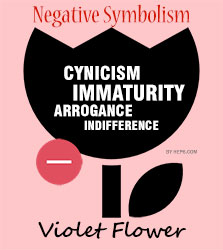
The Violet Flower is sometimes associated with the color Violet’s symbolical meanings.
The representation can be used at times to indicate immaturity, impracticability, cynicism, indifference, and arrogance.
VI
Violet Flower Cultural Symbolism
The monks of the Middle Ages called the Viola tricolor (common in Europe), the “herba trinitatis” (“Herb of the Trinity”) because they saw the symbol of the trinity in their three colors. It was also known as “Our Lady’s Modesty” because it was said to have blossomed when Mary said to the Angel Gabriel, she is the handmaid of the Lord.
The herbs were utilized by the Greeks and Persians to treat heart and brain ailments as well as to reduce aggression and aid in sleep. A broken heart was also soothed by steeping Violet blossoms in hot water.
Besides using Violets to make wine, the Romans used them for table decorations because they thought the blooms could keep people from getting wasted. Romans wore Violet wreaths the mornings after their celebrations to help them recover from hangovers. Pliny, a naturalist of the early Roman Empire, noted Violets’ therapeutic benefits and recommended them for spleen and gout conditions.
VII
Violet Flower Zodiac Sign

February’s birth flower is Violet, which is a symbol of modesty, humility, spiritual wisdom, and faithfulness. According to Greek mythology, Violets first appeared when one of Artemis’ nymphs—who had all vowed to be maidens—was sought out by Artemis’ twin brother Apollo. In order to protect her, Artemis transformed her nymph into a Violet, which later came to stand for modesty. The Violet also represents the modesty of the Virgin Mary and has Christian roots as well. Additionally, the Violet represents spiritual wisdom, loyalty, and humility. These associations are depicted in religious art. Thrilling representations that will appeal to the loyalty and modesty of Capricorns.
VIII
Violet Flower in Dreams
The presence of Violets in your dreams means good success with regards to your endeavors. Moreover, there are people who believe that dreaming of the Violet Flower is an indication telling you of a later time where you will wed a younger person.
IX
Violet Flower Omens and Superstitions
There have been beliefs that to fend off malevolent spirits, you should carry Violets. In fact, it has been used to prevent vertigo by wrapping a Violet wreath around the head to cast off the dizzy sensation. In rural Germany, it was traditional to place Violet Flowers in the cradle of newborn girls as well as on the bridal bed.
The Violet Flower is also considered a lucky gift to send to a woman for it will bring her good fortune.
Furthermore, if Violets bloom in fall, it means an epidemic will happen.
X
Violet Flower Mythology and Folklore
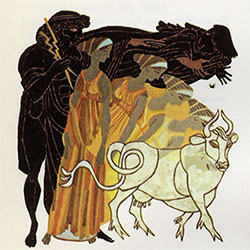
Many legends include Violets in them. It was even mentioned in Homer’s Hymn where the Earth Mother Demeter’s daughter, the goddess Persephone, while in a meadow picking different flowers including Violets with her companion nymphs, they were captured by the deity Hades. Pluto (Hades) is the son of the Titans Cronus and Rhea, abducted Persephone to take her to live in the underworld with him.
There is also a Greek mythology which describes Io as one of Zeus’s lovers who was uncovered by Hera. Legend has it that Hera was envious of Io. This has resulted to Io being transformed into a white heifer. Zeus made a field of Violets for her but Hera requested for her as a present only to have her guarded by the giant Argos. Io could only graze on the delicious, white Violets being offered to Hera in her altered state.
Another story was when Venus and Cupid, her son, were debating whether she or a bunch of young maidens were more attractive. Cupid chose the young girls. Venus became so furious that she thrashed her rivals until they became blue and violet. Violets gained popularity as a love remedy and aphrodisiac due to their association with Venus.
The playwright Aristophanes referred to Athens in antiquity as the “Violet-Crowned City.” Because Ion, the mythological founder of Athens who was crowned there, was an exact match of “ion,” the Greek word for Violet. Legend has it that while Ion was leading his people to Attica, water nymphs greeted him and handed him Violets as a token of their good wishes. As a result, Violets were adopted as the city’s emblem and a need for every Athenian wedding, altar, and residence.

